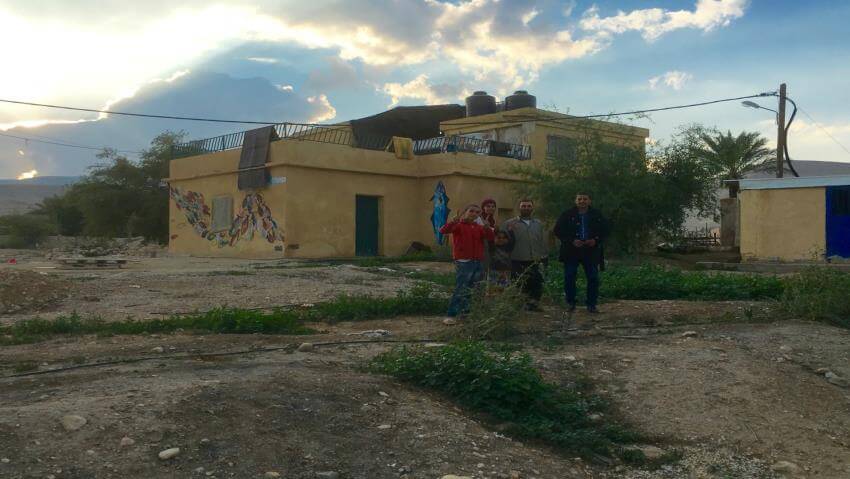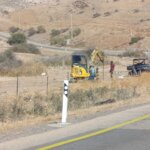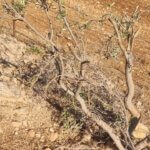Al Araby: Palestine’s Lost Present
“Groups like Save the Jordan Valley display a new kind of resistance” Vijay Prashad
First published by Al Araby 31st December 2015
Magic hangs in the air above the Jordan Valley.
It is here that the ancient prophets went mad in the desert. They spun their yarns of encounters with God, and produced stories that calmed the fears of people at the mercy of nature.
If you squint your eyes, you can imagine John the Baptist, shrouded in camel hair, walking towards the Jordan River, followed by a swarm of locusts. Roads slice the landscape now, but the mystery of the rock and the shrub remains.
The main artery along the north-south axis is Derekh Gandi or Gandhi Road [Derekh being the Hebrew word for path – all the mystical implications intact – which is now used to describe the more mundane asphalt variety].
Who does this Gandhi refer to? To Mahatma Gandhi, only obliquely, because the actual referent is to a man who is the very opposite of Gandhi – Rehavam “Gandhi” Zeevi. Leader of the Moledet (Homeland) Party, Zeevi advocated for the forced removal of Palestinians from the Jordan Valley to other countries.
For Zeevi, who was assassinated by the Popular Front for the Liberation of Palestine in 2001, Palestinians have no right to their soil. Zeevi is not only remembered by this road, but also in Israeli state policy.
Along the road are Palestinian villages and Israeli settlements, divided by military cordons and encampments. Although the 1994 Oslo Agreement allocated the Jordan Valley for a future Palestinian state, 93.4 percent of the land is in Israeli control, part of Area C.
On that land, there are now close to 40 Israeli settlements, deemed illegal under international law, which use twice the amount of arable land available to the Palestinians.
Rashid Sawafta of Save the Jordan Valley tells me that the Israelis forbid Palestinians from using around 85 percent of the land. The Israelis claim that this land is state land, military land or nature reserves.
The Israelis – under the pretext of military control – have seized water sources. This is why the settlement farms seem to bloom, while the Palestinian land struggles to provide for the people.
Zeevi’s dreams for the Jordan Valley are not isolated. Last week, in the Israeli Knesset’s Land to Israel Caucus, Education Minister Naftali Bennett called once more for the annexation of the entire West Bank – with the fertile Jordan Valley as the prize.
It is widely known that the settlements in the Jordan Valley produce windfall profits for Israel. A recent study by Nur Arafeh, Samia al-Botmeh and Leila Farsakh for al-Shabaka found that 40 percent of date exports from Israel come from the Jordan Valley, and the exploitation of this land provides Israel with an annual revenue of around $130 million.
These are resources stolen from the Palestinians under the Oslo agreement.
Over the past five years, according to a Haaretz investigation, $220 million in private US donations have subsidised the settlements. Because this money comes through non-profit organisations, the US government allows them to come to the West Bank without collecting tax – this means the US taxpayer is also financing the settlements.
Backed by the Israeli state and funded by these US subsidies, these settlements have bloomed in the Occupied Palestinian Territories.
In Fasayal al-Fouqa, at the Save the Jordan Valley centre, Rashid details the daily humiliations of life for Palestinian farmers. Since Israel refuses to sanction plans for the villages, the farmers build illegally. These homes are then routinely and viciously destroyed.
Fields are uprooted, water is diverted, dreams are broken.
I have read reports of this atrocity and that one, unable to concentrate. Facts are important to build the case against the occupation – but the particulars are overwhelming. The scales of justice tipped over a long time ago. My mind – at least – cannot digest the information about confiscations in Fasayal village or demolitions in al-Hadidiya. The stench of the atrocity is everywhere.
How to survive the occupation
Further south, near the fabled town of Jericho sits the Oasis Hotel, formerly the Intercontinental Hotel – with a casino. The plan had been for this hotel to attract Israeli tourists, who would want a Las Vegas in the Palestinian desert.
The Second Intifada put paid to this plan.
Behind the hotel is a vast tract of land marked out for the development of Jericho Gate, a 740-acre plot for the construction of hotels, luxury villas, a water park and a museum. The desert now threatens to reclaim the plans of the Palestinian investors, led by Munib al-Masri’s Padco Holdings.
It is so far from the worries of the farmers of Fasayal and al-Hadidya.
This is a neo-liberal fantasy that is born out of one failure – a casino – and threatens another. A few years ago, Padco’s chair, Samir Hulileh, told the press: “There is no way that anyone can know when this conflict will end, and we believe it’s a must that people should survive the conflict and survive the process until it ends. Survival does not mean that we just barely live.”
At the other end of Jericho is a billboard that indicates the tempo of the Palestinian Authority. It depicts a young girl blowing a dandelion.
The caption is fascinating “Is your food halal? Stealing electricity is haram by sharia law.” Not far from this billboard is a painting on a wall that depicts Yasser Arafat and Abu Jihad – the latter with black tears streaming down his eyes.
In 2013, the Center for Development Studies at Birzeit University – along with the Palestinian Authority’s Ministry of Planning and Administrative Development – produced a national strategic plan for Area C and for the Ghor (the northern end of the Jordan Valley).
The plan showed that if the Israelis vacated Area C, the potential economic contribution from the area would be at least a third of the current Palestinian GNP (more than $3 billion of a $10 billion economy). The document, says Raja Khalidi – a Palestinian development economist – “was never formally adopted by the Palestinian Authority, never revealed to the public that had ‘participated in its ownership’, while donors meekly avoid insisting on seeing what they had long requested”.
The plan, Khalidi tells me, “remains deeply buried in the now defunct Ministry of Planning”. That ministry has been dissolved into the Ministry of Finance.
Meanwhile, in the Ghor earlier in December, Israeli settlers set their hunter dogs on 18-year-old Rami Daraghmeh as he took his sheep to graze. The main provider for his family, Rami was seriously hurt in his left leg. This was a routine attack. Another one for Rashid’s list.
Evidence of resistance is in the existence of groups such as Save the Jordan Wall, Stop the Wall, and the Popular Committees. These are legion, documenting the threats to Palestinian existence, defending this house and that family.
Their mode is defensive. The attitude of the illegal settlers suggests that they know this. History, tragically, seems so far to be on their side.
Boycott campaigns against settlement agriculture would open up another pathway. The European Union has now set guidelines for labels to be placed on products produced in settlements.
This is like placing labels that say “Made by Child Labour” or “Blood Diamonds”. What is illegal should be illegal – it should not be allowed as a choice. But it is a start.
This article originally appeared in Al Araby.
Vijay Prashad’s most recent book is No Free Left: The Futures of Indian Communism (New Delhi: LeftWord Books, 2015).






